Last Updated on May 26, 2024 by Kittredge Cherry
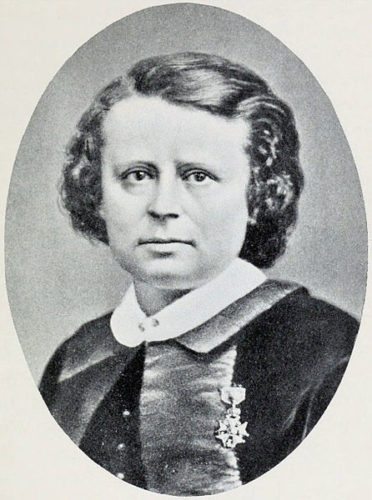
Rosa Bonheur, the most famous female painter of the 19th century, was a queer cross-dresser who honored what she called the “androgyne Christ.” She had two consecutive long-term relationships with women. Her 200th birthday is March 16, 2022. She died on May 25, 1899.
Born in France on March 16, 1822, Bonheur received much acclaim in her lifetime for her paintings of animals. In recent decades she has been celebrated as a queer pioneer, feminist icon, and role model for the LGBTQ community. Her achievements grew out of an unusual religious upbringing in the proto-feminist Saint-Simonian sect, and the queer Christian ideals that she expressed in adulthood. Bonheur’s gender-bending lifestyle has been covered extensively by scholars, but her spirituality has received much less attention.
 Her parents raised her in Saint-Simonianism, a French utopian Christian-socialist movement that advocated equality for women and prophesied the coming of a female messiah. Her father was an artist and an ardent apostle for the Saint-Simonian religion. Bonheur writes a whole chapter about growing up as a Saint-Simonian in the book “Rosa Bonheur: The Artist’s (Auto)biography,” which she wrote with her companion Anna Klumpke.
Her parents raised her in Saint-Simonianism, a French utopian Christian-socialist movement that advocated equality for women and prophesied the coming of a female messiah. Her father was an artist and an ardent apostle for the Saint-Simonian religion. Bonheur writes a whole chapter about growing up as a Saint-Simonian in the book “Rosa Bonheur: The Artist’s (Auto)biography,” which she wrote with her companion Anna Klumpke.
The Saint-Simonian concept of gender equality paved the way for Bonheur’s father to train her as a painter — and for her own defiance of gender norms. As she put it, “To his doctrines I owe my great and glorious ambition for the sex to which I proudly belong and whose independence I shall defend until my dying day.”
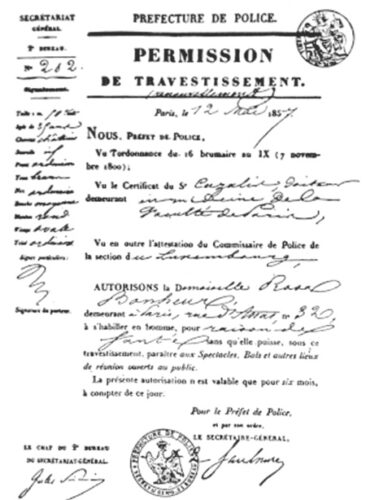
Document granting Rosa Bonheur permission to cross-dress (Wikimedia Commons)
Cross-dressing was illegal in France at that time, but she got permission from the police to wear men’s trousers so she could sketch at such male-dominated places as horse fairs and slaughterhouses. She broke rules of feminine behavior by smoking cigars and wearing her hair short. She was never arrested for wearing men’s clothes, but she was arrested once in female attire when a policeman thought she was a man pretending to be a woman!
Bonheur had two female companions in her lifetime. She spent 50 years living with her childhood sweetheart Nathalie Micas (1824-1889).
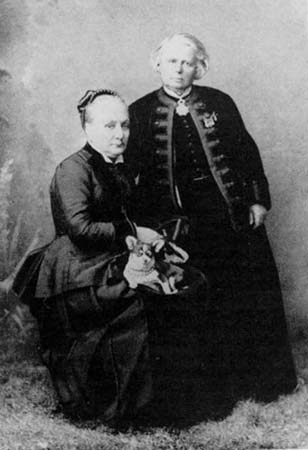
Rosa Bonheur (standing) and her longtime companion Natalie Micas, 1882, in Nice, France (Wikimedia Commons)
“Divine marriage” of two women artists
Bonheur grieved deeply for Micas and then shared the last years of her life with a new companion, American painter Anna Klumpke (Oct. 28, 1856 – Feb. 9, 1942). Klumpke had been fascinated with Bonheur since childhood, when she received a “Rosa” doll as a gift. Bonheur was so famous back then that dolls were fashioned in her image. Klumpke grew up to become a talented portrait artist. Determined to paint Bonheur’s portrait, she approached her 1889 under the pretext of being an interpreter for a horse dealer.
Eventually Bonheur proposed “a divine marriage of two souls” and Klumpke gladly accepted, as recorded in the memoir / autobiography that she wrote with Bonheur. (p .70).
“Friendship, a divine affection nobler than transitory love, province of the Gods, is the place you come from. Your home is in the Heavens, “Bonheur told her. “This divine affection never grows old. It last beyond our earthly existence. There is nothing greater or purer. The love of one soul for another is true kinship. It even surpasses our God-given families; for, instead of receiving it from the Creator’s hands, we choose it for ourselves.” (pp. 78-79)
They lived together in Bonheur’s estate until the older artist died about a decade later. Klumpke’s 1898 portrait of Bonheur at her easel hangs in the prestigious Metropolitan Museum of Art in New York City.
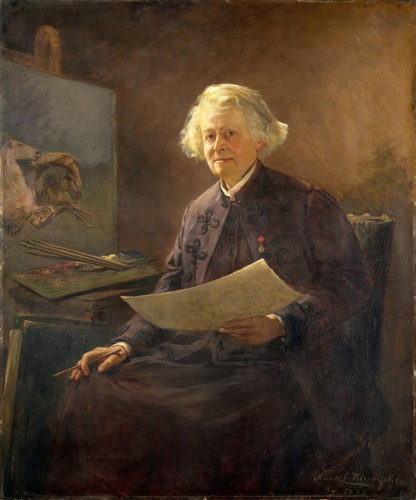
Rosa Bonheur portrait by her companion Anna Klumpke, 1898 (Wikimedia Commons)
One of their joint projects was writing Bonheur’s autobiography. In it Bonheur discusses her religious beliefs, stating, “I get blamed for not going to church! I may have more religion than the folks who, instead of doing their best to lead a blameless life, go mutter prayers there every day in a language they don’t understand…. I’ve written my own versions of the most important Catholic prayers.”
Bonheur wrote liberating prayers
Here are some excerpts from prayers written by Bonheur and published in her autobiography:
Bonheur’s version of the Hail Mary prayer. She lifts up the earth in a beautiful way, although she adds to women’s erasure by deleting Mary:
Hail, O earth full of grace, the living God is with you. Blessed are you among all the planets, the fruit of your womb is our salvation. Holy earth, mother of love, pour out your grace on those who suffer, now and in our divine transformation.
From Bonheur’s Creed:
I believe in God the all-powerful, everlasting Father, creator of all things eternal. I believe in his beloved Son, the saving Two, androgyne Christ, the highest point of human transformation, the sublime manifestation of the living God who is in everything that is.
Bonheur died at age 77, and Klumpke went on to champion Bonheur’s work until she died in 1942. Bonheur, Klumpke and Micas are all buried together in a grave in Paris.
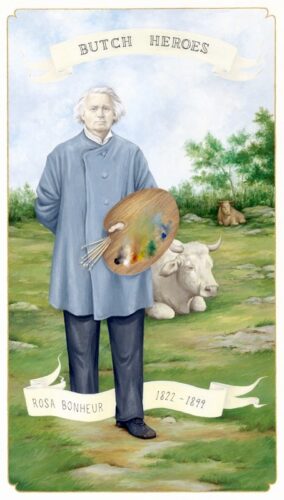
“Rosa Bonheur” by Ria Brodell
A portrait of Bonheur is included in the “Butch Heroes” series by Ria Brodell, a culturally Catholic nonbinary trans artist in the Boston area. For more about Brodell, see “Artist paints history’s butch heroes: Ria Brodell interview.”
Bonheur’s most famous paintings are “The Horse Fair” and “Plowing in the Nivernais,” but she leaves a large legacy of art depicting horses, cattle, sheep, lions, dogs, and many other creatures. A selection of her work is posted below.

“Royalty at Home” by Rosa Bonheur (Wikimedia Commons)

“The Horse Fair” by Rosa Bonheur (Wikimedia Commons)

“Relay Hunting” by Rosa Bonheur (Wikimedia Commons)

“Plowing in the Nivernais” by Rosa Bonheur (Wikimedia Commons)
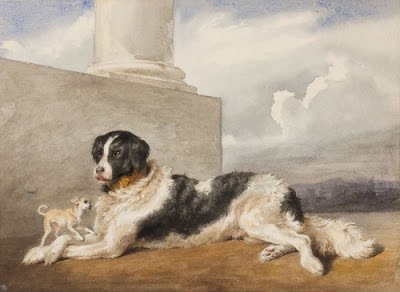
“Sultan and Rosette” by Rosa Bonheur (Wikimedia Commons)
___
Related link:
Prière au Christ Arc-en-Ciel: le drapeau LGBT révèle le Christ queer (Rainbow Christ Prayer in French)
___
Top image credit:
Rosa Bonheur, 1865, wearing the medal of the Legion of Honor (Wikimedia Commons)
___
Related links:
Rosa Bonheur (Art History Archive)
Rosa Bonheur at the Legacy Project
The Portrait That Forged a “Divine Marriage” Between Two 19th-Century Women Painters (hyperalleric.com)
____
This post is part of the LGBTQ Saints series by Kittredge Cherry. Traditional and alternative saints, people in the Bible, LGBTQ martyrs, authors, theologians, religious leaders, artists, deities and other figures of special interest to lesbian, gay, bisexual and transgender and queer (LGBTQ) people and our allies are covered.
This article was originally published on Q Spirit in May 2017, was expanded with new material over time, and most recently updated on May 25, 2024.
Copyright © Kittredge Cherry. All rights reserved.
Qspirit.net presents the Jesus in Love Blog on LGBTQ spirituality.




















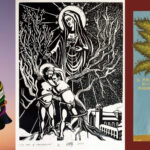

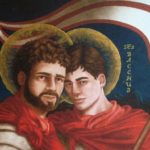
This article implies Bonheur’s “relationships” with women were lesbian romances but also quotes Bonheur herself describing the second one as “”Friendship, a divine affection nobler than transitory love”.
Prof Prem raj Pushpakaran writes — 2022 marks the birth bicentenary year of Rosa Bonheur and let us celebrate the occasion!!!
http://www.academicroom.com/users/drpremrajp
Ms. Cherry: After reading your brief bio I am more than pleased that you accepted my Friend message. I am not that well-acquainted with FACEBOOK, and am not a fan, usually. But it is a
spectacular way of connecting,
& I’m looking forward to doing just that with you. I was licensed
with MCC in 1983, I have a BA(1960) in Speech Therapy/Music & an MS (1990)
in Counseling. I have been a student of The WORD since the 70’s. I was pastor of MCC of the Gentle Shepherd in Vancouver, Wa. (1983 – 1990). I married in 1957, divorced in 1974, and have
7 children, 12 grandchildren (1 is
deceased), and 4 great-grandchildren. I am excited to
talk/share about many things,
especially Words! Til then, your
Friend, Joyce!